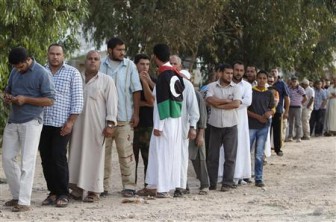MISRATA, Libya, (Reuters) – Muammar Gaddafi’s body lay in an old meat store today as arguments over a burial, and his killing after being captured, dogged efforts by Libya’s new leaders to make a formal start on a new era of democracy.
With a bullet wound visible through the familiar curly hair, the corpse shown to Reuters in Misrata bore other marks of the violent end to a violent life, still being broadcast to the world on looping snatches of grainy, gory cellphone video.

The interim prime minister offered a tale of “crossfire” to explain the fallen strongman’s death after he was dragged, very much alive, from a highway drain in his hometown of Sirte. But seeing him being beaten, while demanding legal rights, to the sound of gunfire, many assume he was simply summarily shot.
Gaddafi’s wife, Aisha, who found refuge in neighbouring Algeria while her husband and several sons kept their word to fight to the death, was reported to want an inquiry from the United Nations. Its human rights arm said one was merited.
Controversy over the final moments of a man who once held the world in thrall with a mixture of eccentricity and thuggery raised questions about the ability of Libya’s National Transitional Council to control the men with guns, as well as discomfort for Western allies about respect for human rights among those who claimed to be fighting for just those ideals.
The body appeared to be the latest object of wrangling among the factions of fighters who overthrew him — along with control of weapons, of ministries and of Libya’s oil wealth.
Libyans, and the Western allies who backed the revolt that ended Gaddafi’s 42-year rule two months ago, have indicated their impatience to begin what the United States declared was a democratic “new era”. NATO was expected to agree on Friday to start winding down its seven-month air campaign over Libya.
But regional and other rivalries have been holding up the disposal of the corpse of Gaddafi, who was seized by fighters on Thursday, and a formal declaration of Libya’s “liberation”.
BURIAL DISPUTE
“They are not agreeing on the place of burial. Under Islam he should have been buried quickly but they have to reach an agreement whether he is to be buried in Misrata, Sirte, or somewhere else,” a senior NTC official told Reuters.
Others said talks were under way with members of Gaddafi’s tribe to dispose of him in secret, avoiding creating a shrine.
In Misrata, a local commander, Addul-Salam Eleiwa, showed off the body, torso bare, on a mattress inside a metal-lined cold-store by a market. He said: “He will get his rights, like any Muslim. His body will be washed and treated with dignity. I expect he will be buried in a Muslim cemetery within 24 hours.”
But amid the rumour and counter-rumour swirling between Sirte, Gaddafi’s last bastion, and Misrata, whose siege at his hands made it a symbol of resistance, nothing was certain.
Interim oil minister Ali Tarhouni said he urged colleagues to hold off burying Gaddafi for several days. Dozens of people, many with cellphone cameras, filed in to see that he was dead.
In a small triumph for those who were inspired by Arab Spring uprisings elsewhere to launch the rebellion in February in Benghazi, the eastern city was chosen as the venue for NTC chairman Mustafa Abdel Jalil to make announce the whole country liberated on Saturday, several NTC officials told Reuters.
That will set a clock ticking on a tentative timetable for drafting a constitution, under which full parliamentary elections would, Libyans hope, take place within a year or two.
There has been tension between the easterners and leaders from Misrata, Tripoli and other western cities, who take credit for overrunning the capital in August and complain they are under-represented in an interim government which has yet to move fully to Tripoli. Under the post-liberation plan, that is supposed to happen within weeks, though some in Benghazi, home to much of the oil industry, are keen to decentralise power.

